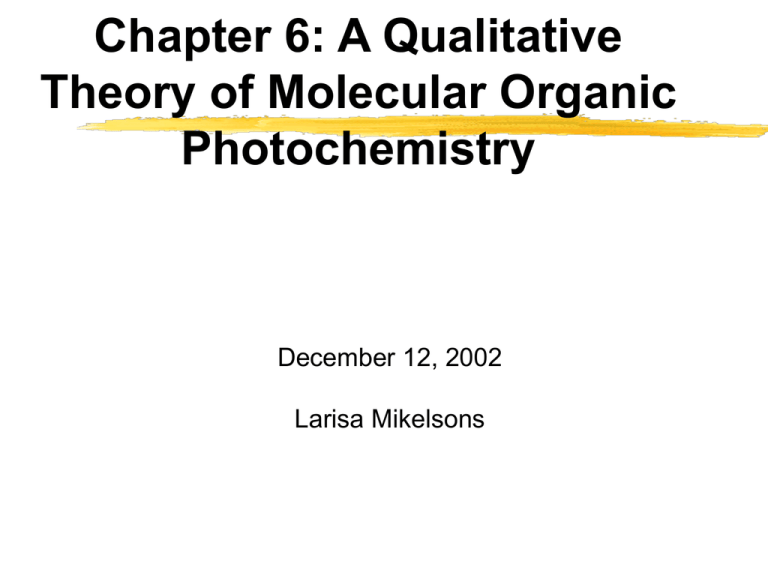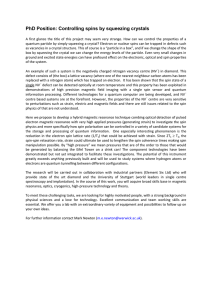Chapter 6: A Qualitative Theory of Molecular Organic Photochemistry December 12, 2002
advertisement

Chapter 6: A Qualitative Theory of Molecular Organic Photochemistry December 12, 2002 Larisa Mikelsons Simplified schematic of the 2 lowest singlet surfaces for a concerted pericyclic reaction: 4N e- concerted disrotatory pericyclic reactions are generally photochemically allowed 4N + 2 e- concerted disrotatory photoreactions are generally photochemically forbidden QuickTime™ and a GIF decompressor are needed to see this picture. Concerted pericyclic reactions which are g.s. forbidden are generally e.s. allowed in S1 due to a miminum which corresponds to a diradicaloid Pericyclic reactions which are g.s. allowed are generally e.s. forbidden in S1 because of a barrier to conversion to product structure and the lack of a suitable surface crossing from S1 to S0 4N or 4N + 2 = # of e-s involved in bond making or bond breaking 6.11 Typical State Correlation Diagrams for Nonconcerted Photoreactions Orbital correlation diagram for H-abstraction by formaldehyde: Most photochemical reactions are not concerted and involve reactive intermediates (D, Z) along *R I Use H-abstraction reaction of the n,* state of ketones as an exemplar for *R I reactions QuickTi me™ and a GIF decompressor are needed to see this picture. Assumption: the strictly planar approach represents the reaction coordinate (gives the best frontier orbital interaction between nO and XH; orbitals can be readily classified) XH pX and nO OH correlations are assumed to be avoided State symmetries can be deduced from the orbital correlation diagram First Order state correlation diagram for coplanar H-abstraction: S1 and T1 correlate with the lowest states of the product and coplanar H-abstraction is symmetry-allowed. QuickTime™ and a GIF decompressor are needed to see this picture. S2 and T2 correlate with zwitterionic forms of the product (which have very high energies) and coplanar H-abstraction is symmetry-forbidden. Destruction of the perfect coplanar geometry results in a weakly avoided crossing between the S11D and S0Z1 surfaces. The T13D and S0Z1 remains. 6.13 State Correlation Diagrams for -Cleavage of Ketones Orbital symmetries for the -cleavage of acetone: Two diradicaloid geometries possible: a) QuickTi me™ and a GIF decompressor are needed to see this picture. a bent acyl which is s b) a linear acyl fragment with s and a orbitals. The (s,p) state is S and the (a,p) state is A Orbital correlation diagrams for -cleavage of acetone: QuickTi me™ and a GIF decompressor are needed to see this picture. Zero Order state correlation diagram for -cleavage of acetone: For symmetry-allowed -cleavage of n, * states to yield a linear acyl fragment, S1(n,*) and T1(n,*) correlate with 1D(a,pc) and 3D(a,pc). For symmetry-forbidden -cleavage of n, * states to yield a bent acyl fragment, S1(n,*) and T1(n,*) correlate with D*(sp2,*CO). First Order correlation diagram for -cleavage of acetone: Situation for cleavage to the linear fragment essentially the same QuickTime™ and a TIFF (U ncompressed) decompressor are needed to see this picture. Occurrence of weakly avoided crossings for cleavage to the bent acyl fragment 6.14 A Standard Set of Plausible Primary Photoreactions for , * and n, * States Plausible primary photochemical reactions that are initiated in S1(, *) T1(, *) 1. Concerted pericyclic reactions 2. Reactions characteristic of carbonium ions and of carbonanions 3. Cis-trans isomerization 1. Hydrogen atom or e- abstractions 2. Addition to unsaturated bonds 3. Homolytic fragmentations 4. Rearrangement to a more stable carbon centered radical Zwitterionic and/or concerted Diradicaloid and non-concerted The photochemistry of n,* states is completely diradicaloid to a good approximation. The plausible primary processes are: n-Orbital Initiated *-Orbital Initiated Atom abstraction Radical addition Electron abstraction -Cleavage Atom abstraction Radical addition Electron donation -Cleavage Electrophilic characteristics Like an alkoxy radical (RO•) Sensitive to steric factors influencing substrate’s approach in molecular plane and near “edges” of carbonyl O Nucleophilic characteristics Like a ketyl radical (R2COH•) Sensitive to steric factors influencing substrate’s approach above and below the “faces” of CO 6.15 Intersystem Crossing in Radical Pairs and Diradicals S11I processes: No spin prohibition to 1IP so 1I = 1RP, 1D 1I undergo either recombination or disproportionation which are both extremely rapid Reactions may be stereospecific T13I processes: Spin prohibition to 3IP due to 3I1I If ISC is slow relative to diffusional separation of the radical pair then free radical formation occurs If ISC is slow relative to rotation about C-C bonds then loss of stereochemistry results in any intramolecular reactions of the diradical Rate of ISC in RP and D determined by spin-orbit interactions and possibly by very weak magnetic interactions with nuclear spins and laboratory magnetic fields 6.16 Magnetic Energy Diagrams Including the Electron Exchange Interaction Important situations of Zeeman splitting and exchange splitting: gB0 gB0 T T+ T+ S decreases in energy as J increases S T0 T0 S J T- TS Condition I (low field, J = 0) Condition II (low field, J = 0) Condition I Solvent separated spin correlated geminate pairs and extended biradicals Condition II Molecular triplets, spin correlated pairs in a solvent cage and small biradicals S Condition III (high field, Condition IV (high field, J ~ gB0 ) J >> gB0) 6.17 Magnetic Interactions and Magnetic Couplings Magnetic couplings that are important for ISC: spin-orbit coupling, electron-nuclear hyperfine coupling and Zeeman coupling. Dipolar interaction (Eq. 6.12) Nucleus with spin Contact interaction (Eq. 6/13) Electron spin outside nucleus Due to electric or to magnetic dipoles interacting Interaction [(12)/r3](3cos2 - 1) (overlap integral) Rate (strength of the interaction)2 1 / r6 Electron spin inside nucleus Due to overlap of wavefunctions Interaction ep|(0)|2 Interaction distance independent Magnetic Coupling Mechanisms Spin Hamiltonian operator H used to classify the magnetic coupling mechanism of an electron spin, S1, with other magnetic moments Zeeman Coupling: external coupling of electron spin to the magnetic moment of an applied laboratory field. HZ = geH0S1 Dipole-dipole Coupling: internal coupling of electron spin to the magnetic moment of another electron spin, S2. HDP = DeS1S2 Hyperfine Coupling: internal coupling of electron spin to the magnetic moment of a nuclear spin, I. HHF = aS1I Spin-orbit Coupling: internal coupling of electron spin to the magnetic moment due to orbital motion of the electron, L. HSO = S1L Spin-lattice Coupling: coupling of electron spin to the oscillating magnetic fields resulting from molecular motions of the environment. HSL S1L Spin-photon Coupling: coupling of electron spin to the oscillating magnetic field associated with an electromagnetic field. Hh S1h 6.18 Coupling Involving Two Correlated Spins z S1 z S2 S1 z S2 S1 S2 Hi Hi S1 and S2 coupled and precess about each other, Hi uncoupled Hi S2 and Hi precess about resultant S2 uncoupled from S2 and becomes coupled to Hi z z S1 S2 Hi S1 HX or HY S2 Hi Zero field T S T+ T High Field T0 T- S T+ X S T+ S and T- S Transitions Initially S1 and S2 are correlated in T+ Hi (electron or nuclear spin) couples with S2 and causes T+ S ISC Zero field: three T sublevels strongly mixed and radiationless T+ S ISC plausible (assuming J = 0) High field: radiationless T+ S ISC not plausible but radiative transition is plausible if J is very small X T0 T- S Vector diagram for T- S transition similar to that of T+ S transition T0 S Transitions z z S1 Hi S2 z S1 Hi S2 HZ S2 S2 becomes uncoupled from S2 and becomes coupled to Hi S1 and S2 coupled, Hi uncoupled Zero field T S T0 T- T S Hi (electron or nuclear spin) couples with S1 and causes T0 S ISC Zero field: three T sublevels strongly mixed and radiationless T0 S ISC plausible (assuming J = 0) S High field: radiationless T0 S ISC plausible if J= 0 T+ T+ High Field S1 Initially S1 and S2 are correlated in T0 Hi T0 T- S 6.19 ISC in Radical Pairs and Diradicals. Exemplar Systems Simplified paradigm of a photochemical process proceeding through an n,* triplet electronically excited state, T1: h R 1 I R 1 S0 S1 1 3 3* *R 2 T1 3 RP 3 1 P I 4 RP P Paradigm for the -cleavage reaction of ketones: 1 1 O A B 1R 3 O A 2 B 3R O A ..B 3RP 3 O A O ..B 1RP 4 A + B Other Products Surface energy diagram displaying the spin and molecular dynamic features of a dynamic radical pair: Energy surface description uses the exemplar of the stretching and breaking of a C-C single bond. ISC step S1T1 occurs “vertically” when the exchange interaction is very large When J is large it controls the correlated precessional motion of the two electron spins so only a strong interaction can induce ISC When the RP is not in contact J decreases and torques can cause the electron spin to be rephased or flipped Visualization of Spin Dynamics. ISC in Geminate RPs in Zero Field Distance dependence of spin correlated radical pairs: ISC not plausible during bond breaking since breaking takes 10-13 s while spin precession is of the order of 10-10 s. In region 2 J is large so the spins are strongly correlated and ISC is implausible in the contact pair. In region 3 J is comparable to available magnetic interactions for the pair so the spins are weakly correlated and ISC is plausible. In region 4 J = 0 and neither the phase nor the orientation of the spin on one center influences the phase or orientation of the spin at the other center. 6.20 Energy Surfaces as Reaction Maps or Graphs Orbital interactions and state correlation diagrams supply the basic elements of a qualitative theory of photoreactions. The possible products may be deduced from state correlation diagram maps. The probable products may be deduced from consideration of a) symmetry-imposed barriers b) minima which facilitate pathways from an excited surface to the ground state



